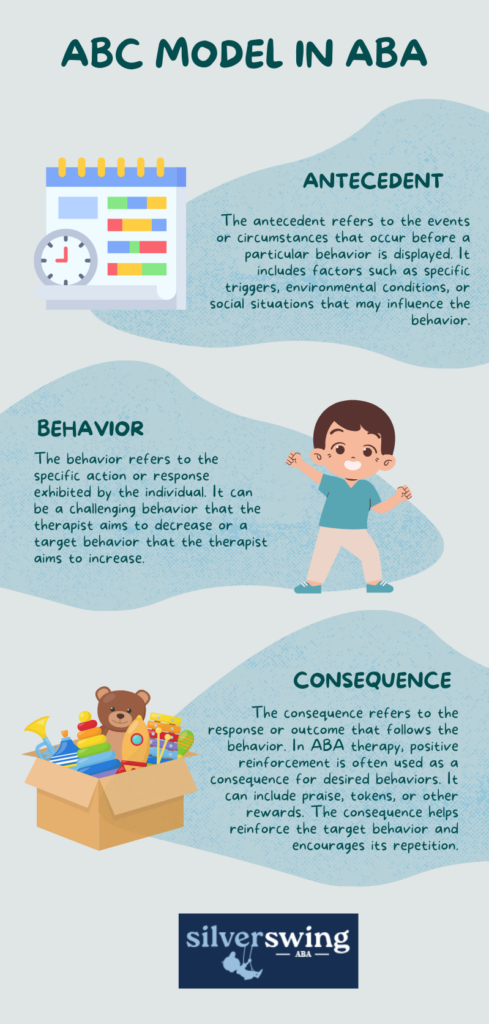Applied Behavior Analysis (ABA) therapy is a widely recognized and evidence-based approach designed to help individuals on the autism spectrum develop social and emotional skills. By working one-on-one with a trained practitioner, individuals with autism can learn and practice new behaviors based on principles of learning theory.
Basics of ABA
ABA therapy follows the principles of Applied Behavior Analysis, where desired behaviors are developed using a rewards-and-consequences system. Therapists identify target skills or behaviors, set goals for individuals, and measure progress throughout the therapy period. The therapy is personalized for each individual, allowing for tailored goals to address specific struggles.
ABA for Autism
ABA therapy is particularly effective for children with autism, and it is recommended to start therapy as early as possible. Research shows that ABA helps children with autism learn and develop essential skills. Most children begin ABA treatment between the ages of 2 and 6. Starting at age 2 can help in developing better communication skills, following directions, and preparing for pre-school. For older children, ABA is often used as part of their education to teach social skills, daily living skills, and to help change problem behaviors.
The goal of ABA therapy for individuals with autism is to help them understand the connection between behaviors and consequences. Positive behaviors are rewarded while negative behaviors are discouraged. Through this process, the desired behaviors learned during therapy can extend into real-world social situations.
ABA therapy is not limited to children; it can also be beneficial for adults with autism and other behavioral disorders. The therapy is personalized to address the unique needs and challenges of each individual, providing proven results in improving social and emotional skills.

Benefits of ABA Therapy
Applied Behavior Analysis (ABA) therapy is a highly effective approach for supporting individuals with autism spectrum disorder (ASD) and other developmental difficulties. It employs evidence-based techniques rooted in behavioral principles to address behaviors and facilitate growth. Tailored interventions and positive reinforcement strategies are utilized to equip individuals with essential skills for improved independence and quality of life.
Social & Emotional Development
One of the primary goals of ABA therapy is to support and enhance social and emotional development in individuals with autism. Through various techniques and interventions, ABA therapists work closely with individuals to help them understand and navigate social interactions, build meaningful relationships, and develop emotional regulation skills.
By breaking down complex social situations into smaller, manageable steps, ABA therapy provides individuals with autism the opportunity to learn and practice appropriate social behaviors. These behaviors can include skills such as making eye contact, initiating conversations, taking turns, and understanding facial expressions and body language.
ABA therapy also focuses on promoting social skills by encouraging individuals to engage in joint activities, cooperative play, and group settings. The therapist provides guidance and support to help individuals understand social cues, recognize others’ perspectives, and develop empathy. Over time, these interventions can significantly improve social functioning and enhance the individual’s ability to form and maintain relationships.
Positive Reinforcement
Positive reinforcement is a fundamental principle of ABA therapy. It involves using rewards or incentives to encourage desired behaviors and increase their frequency. Studies have shown that personal value rewards following a correct behavior make it more likely for the behavior to be repeated over time.
In the context of ABA therapy, positive reinforcement is used to motivate individuals with autism to engage in appropriate behaviors and acquire new skills. When individuals demonstrate desired behaviors, such as following instructions, engaging in social interactions, or completing tasks, they receive rewards that are meaningful to them. These rewards can vary from verbal praise and tokens to preferred items, activities, or privileges.
By using positive reinforcement, ABA therapists create a supportive and encouraging environment that fosters learning and skill development. This reinforcement also helps individuals generalize their newly acquired skills to real-world social situations, enhancing their overall functioning and independence.
It’s important to note that ABA therapy is highly personalized and tailored to the specific needs and goals of each individual. By utilizing the principles of learning theory and individualized interventions, ABA therapy provides proven results for children and adults with autism and other behavioral disorders.

ABA Techniques
ABA therapy utilizes various techniques to address the specific needs of individuals with autism. Two commonly used techniques in ABA therapy are Discrete Trial Training (DTT) and the ABC Approach.
Discrete Trial Training (DTT)
Discrete Trial Training (DTT) is a structured teaching method used in ABA therapy to teach specific skills. It involves breaking down complex tasks into smaller, more manageable steps. Each step is taught individually, providing repeated practice and reinforcement until mastery is achieved. DTT is particularly effective in teaching school-related skills, such as reading, writing, and math.
The DTT process typically involves three components: the discriminative stimulus, the response, and the consequence. The therapist presents a specific instruction or cue (discriminative stimulus) to the individual, who then responds with the desired behavior or skill. If the response is correct, the individual is provided with positive reinforcement as a consequence, such as praise, tokens, or small rewards. If the response is incorrect, the therapist may provide corrective feedback and prompt the individual to try again.
DTT is highly structured and allows for intensive teaching in a controlled environment. It provides clear and consistent prompts, making it easier for individuals with autism to understand and learn new skills. By breaking down complex tasks into manageable parts, DTT helps individuals build a solid foundation of skills, gradually progressing towards more advanced abilities.
ABC Approach
The ABC Approach is a fundamental concept in ABA therapy that helps therapists understand and address challenging behaviors in individuals with autism. ABC stands for Antecedent, Behavior, and Consequence.

By analyzing the antecedents and consequences associated with specific behaviors, ABA therapists can identify patterns and understand the function of the behavior. This understanding enables them to develop strategies to modify the antecedents and consequences, ultimately shaping and replacing challenging behaviors with more appropriate ones. ABA therapy focuses on shifting challenging behaviors into the target behavior through the ABC Approach.
The use of techniques like Discrete Trial Training (DTT) and the ABC Approach are just some examples of the strategies employed in ABA therapy. ABA therapists tailor these techniques to meet the individual needs of each person with autism, helping them reduce challenging behaviors and acquire new skills.
Personalized ABA Therapy
When it comes to ABA therapy for individuals with autism, a key aspect of its effectiveness lies in its ability to be personalized and tailored to each individual’s unique needs. One of the fundamental principles of ABA therapy is setting specific goals for individuals with autism. These goals are carefully crafted based on a comprehensive evaluation of the individual’s unique needs, skills, preferences, interests, challenges, and family situation. A qualified BCBA (Board Certified Behavior Analyst) works closely with the individual and their family to identify target skills or behaviors that will enhance their quality of life.
These tailored goals focus on addressing specific areas of development, such as communication, social skills, self-care, or academic skills. These goals are designed to be achievable and measurable, allowing therapists to track progress effectively.
Individual Progress Tracking
Measuring progress is an essential component of ABA therapy. By collecting data during therapy sessions, therapists can objectively assess the individual’s progress and make informed decisions about treatment adjustments. Progress tracking enables therapists to identify patterns, evaluate the effectiveness of interventions, and make data-driven decisions to optimize the individual’s learning experience.
Therapists use various methods to track progress, including direct observation, data collection sheets, and behavior tracking software. The data collected may include information about target behaviors, skill acquisition, and behavior reduction. Regular meetings between therapists and family members are held to review progress and discuss any necessary adjustments to the treatment plan.
By continuously monitoring progress, ABA therapy ensures that interventions are appropriately tailored and modified to meet the changing needs of the individual. This data-driven approach allows therapists to make evidence-based decisions, optimizing the effectiveness of the therapy and promoting positive outcomes.

Modern Approach to ABA
As with any field, Applied Behavior Analysis (ABA) therapy has evolved over time to better meet the needs of individuals with autism. Modern ABA approaches have moved away from harmful negative reinforcement methods and have shifted towards more respectful and individualized techniques. Let’s explore the evolution of ABA and the respectful methods employed in this therapy.
Evolution of ABA
In the past, ABA therapy faced controversies and criticisms due to its focus on eliminating undesirable behaviors and its use of negative reinforcement. However, the field of ABA has made significant strides in recent years.
The evolution of ABA therapy has led to a more flexible and person-centered approach. Rather than solely targeting the elimination of specific behaviors, modern ABA therapy focuses on teaching necessary skills that help individuals with autism live safer and more fulfilling lives. It aims to improve communication, social relationships, self-help abilities, play, and leisure activities. The goal is to enhance an individual’s life in a way that is meaningful to them, rather than striving for neurotypical appearance.
Respectful methods are at the core of modern ABA therapy. Therapists work closely with individuals with autism and their families to develop individualized treatment plans that consider the unique needs, skills, preferences, interests, challenges, and family dynamics of the person receiving therapy. A qualified Board Certified Behavior Analyst (BCBA) typically designs these plans.
ABA therapy primarily utilizes positive reinforcement and repetition as the main tools for teaching and shaping behaviors. Positive reinforcement involves providing rewards or incentives to reinforce desired behaviors, making them more likely to occur in the future. This approach creates a positive and motivating learning environment.
To ensure progress, data collection is an integral part of ABA therapy. During therapy sessions, therapists collect data to measure progress and make data-driven decisions. This allows for ongoing assessment of an individual’s achievements and helps to guide therapy interventions effectively.
Regular meetings between therapists and family members are also essential in modern ABA therapy. These meetings provide an opportunity to review progress, discuss concerns, and adjust teaching plans as needed. Collaboration between therapists and families creates a supportive and coordinated approach to the individual’s care.
Effectiveness of ABA Therapy
ABA therapy is a highly effective approach that can be applied to individuals with autism across their lifespan. Whether they are young children, adolescents, or adults, ABA has shown to have a positive and lasting impact on individuals with autism.
Effective for All Ages
One of the remarkable aspects of ABA therapy is its effectiveness for individuals of all ages. While the therapy approach may vary depending on the developmental stage and specific needs of the individual, the underlying principles of ABA remain consistent.
For young children with autism, ABA therapy focuses on building foundational skills such as communication, social interactions, self-help abilities, play, and leisure activities. Early intervention with ABA can significantly improve a child’s developmental trajectory and enhance their overall quality of life.
As individuals with autism transition into adolescence and adulthood, ABA therapy continues to play a crucial role in their lives. It can help them learn greater independence, develop vocational skills, and navigate social relationships. By addressing specific challenges and building upon existing strengths, ABA empowers individuals with autism to lead more fulfilling and meaningful lives.

Lifelong Impact
ABA therapy has the potential to create a lifelong impact on individuals with autism. The skills and strategies learned through ABA can be carried forward into adulthood, enabling individuals to continue their personal growth and development.
By focusing on individualized treatment plans, ABA therapists work closely with individuals with autism and their families to identify specific goals and target areas for improvement. These personalized goals allow for a tailored approach that takes into account the unique needs, preferences, and challenges of each individual.
Regular data collection and progress monitoring are integral parts of ABA therapy. By systematically measuring progress and adjusting teaching plans as needed, therapists ensure that the therapy remains effective and aligned with the individual’s evolving needs.
Overall. ABA therapy offers a holistic approach,allowing individuals with autism to unlock their full potential and lead empowered lives.




